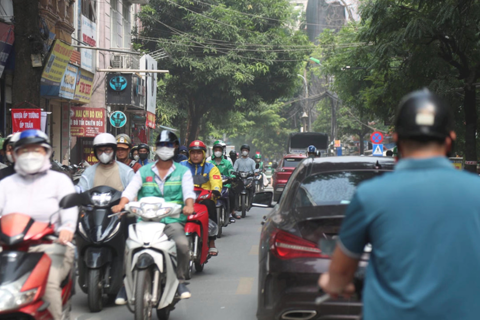Hanoi
Visiting Thanh Giong in Phu Dong temple
Dec 25, 2018 / 08:35 AM
Thanh Giong or Saint Giong is considered the symbol of Vietnam, the heroic nation; and the pride of Vietnamese people.
Gia Lam district is home to a number of relics and places of interest. Phu Dong temple is one of the most beautiful temples in Vietnam and this place has been recognized as a Vietnam’s National Heritage.

Thanh Giong or Saint Giong is considered the symbol of Vietnam, the heroic nation; and the pride of Vietnamese people. He represents what is noble and patriotic in Vietnamese culture. He is also the symbol of the mind, the spirit who always has a place in the heart of all patriotic men. Thanh Giong represents the soul and the braveness in safeguarding the country.
Saint Giong is one of the Four Immortals in Vietnam, in addition to Tan Vien (the God of the Mountain), Chu Dong Tu and the Mother Goddess Lieu Hanh. They are the four chief cult figures in the pantheon of genie worshiped by the Vietnamese people of the Red River Delta region.
Legend has it that a boy was born in Giong Village of Phu Dong commune. At 3 years old, the boy remained speechless and did not even laugh. All day long, he lied in the basket hanging on the bamboo frames. Then the country was invaded by foreign aggressors. The King made an appeal to all citizens to rise up and fight the enemy. The mute boy suddenly grew up so fast, ready for the battle with nothing else but the greatest will: to save his people and his nation. When the war is over, the boy-soldier returned to Mountain Soc and flew up to the sky.
He became the immortal god who blesses peace and prosperity to the people. Every year, people in Phu Dong celebrate festival to remember and appreciate his legacy.
Thuong temple inside the Thanh Giong shrine is worth visiting thanks to its harmonious architecture. Located on the side of Duong River, it features beautiful architectural treasure such as Thuy temple, Gate of Five Elements, Phuong temple and the Guest Chamber.
In the front yard, there is a pond called Roi (Puppet) pond because it is the stage for the villagers to perform the traditional puppet show. Under the banyan tree on the pond side, there is the lovely Thuy temple.
 Moving forward, the Nghi gate is quite high which was built in late nineteenth century. In front of the gate, two stone dragons with engraved script that indicates the time they were made: the year of the chicken, 1705, under the reign of King Le Du Tong. Two stone lions behind also were made in the same year.
Moving forward, the Nghi gate is quite high which was built in late nineteenth century. In front of the gate, two stone dragons with engraved script that indicates the time they were made: the year of the chicken, 1705, under the reign of King Le Du Tong. Two stone lions behind also were made in the same year.

Next, the Incense burning chamber had the structure similar to Thuy Temple but in a smaller size. Two large chambers flanked the incense burning chamber. There are 39 bricks installed in the shape of a dragon at the entrance to the shrine. Two chambers with three rooms on the East were built to worship Dang Thi Hue- the spouse of Lord Trinh Sam (18th century).
Inside the back chamber, there is a Giong statue with 3 meters high. On both sides, there are sculptures of six generals, two geese and four servants.
Besides the beauty of the architectural complex, the value of Phu Dong temple is certainly recognized through the various royal edicts it houses which belong to the reign of king Le Trung Hung, Tay Son and Nguyen dynasties, those artifacts represent the excellence of Vietnam handicraft and contained a deep philosophical concept. At the temple, there is also a stone pillar built in 1660 with extremely beautiful sculptures. There is also Ngoc (Jade) well on the back of the temple.
Besides Thuong temple, Phu Dong temple also had seven location of vestiges, which are distributed in three villages of Phu Dong commune, covering a total area of 60.343,7 m2. They are Ha temple, Ban temple, Ha Ma temple, Kien So pagoda, among others.

Saint Giong is one of the Four Immortals in Vietnam, in addition to Tan Vien (the God of the Mountain), Chu Dong Tu and the Mother Goddess Lieu Hanh. They are the four chief cult figures in the pantheon of genie worshiped by the Vietnamese people of the Red River Delta region.
Legend has it that a boy was born in Giong Village of Phu Dong commune. At 3 years old, the boy remained speechless and did not even laugh. All day long, he lied in the basket hanging on the bamboo frames. Then the country was invaded by foreign aggressors. The King made an appeal to all citizens to rise up and fight the enemy. The mute boy suddenly grew up so fast, ready for the battle with nothing else but the greatest will: to save his people and his nation. When the war is over, the boy-soldier returned to Mountain Soc and flew up to the sky.
He became the immortal god who blesses peace and prosperity to the people. Every year, people in Phu Dong celebrate festival to remember and appreciate his legacy.
Thuong temple inside the Thanh Giong shrine is worth visiting thanks to its harmonious architecture. Located on the side of Duong River, it features beautiful architectural treasure such as Thuy temple, Gate of Five Elements, Phuong temple and the Guest Chamber.
In the front yard, there is a pond called Roi (Puppet) pond because it is the stage for the villagers to perform the traditional puppet show. Under the banyan tree on the pond side, there is the lovely Thuy temple.


Inside the back chamber, there is a Giong statue with 3 meters high. On both sides, there are sculptures of six generals, two geese and four servants.
Besides the beauty of the architectural complex, the value of Phu Dong temple is certainly recognized through the various royal edicts it houses which belong to the reign of king Le Trung Hung, Tay Son and Nguyen dynasties, those artifacts represent the excellence of Vietnam handicraft and contained a deep philosophical concept. At the temple, there is also a stone pillar built in 1660 with extremely beautiful sculptures. There is also Ngoc (Jade) well on the back of the temple.
Besides Thuong temple, Phu Dong temple also had seven location of vestiges, which are distributed in three villages of Phu Dong commune, covering a total area of 60.343,7 m2. They are Ha temple, Ban temple, Ha Ma temple, Kien So pagoda, among others.








